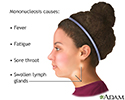Cytomegalovirus (CMV) infection
CMV mononucleosis; Cytomegalovirus; CMV; Human cytomegalovirus; HCMV
Cytomegalovirus (CMV) infection is a disease caused by a type of herpes virus.
Causes
Infection with CMV is very common. The infection is spread by:
- Blood transfusions
- Organ transplants
- Respiratory droplets
- Saliva
- Sexual contact
- Urine
- Tears
Most people come into contact with CMV in their lifetime. But usually, it's people with a weakened immune system, such as those with HIV/AIDS, who become ill from CMV infection. Some otherwise healthy people with CMV infection develop a mononucleosis-like syndrome.
CMV is a type of herpes virus. All herpes viruses remain in your body for the rest of your life after infection. If your immune system becomes weakened in the future, this virus may have the chance to reactivate, causing symptoms.
Symptoms
Many people are exposed to CMV early in life, but do not realize it because they have no symptoms, or they have mild symptoms that resemble the common cold or flu. These may include:
- Enlarged lymph nodes, especially in the neck
- Fever
- Fatigue
- Loss of appetite
- Malaise
- Muscle aches
- Rash
- Sore throat
CMV can cause infections in different parts of the body. Symptoms vary depending on the area that is affected. Examples of body areas that can be infected by CMV are:
- The lungs
- The stomach or intestine
- The back of the eye (retina)
- A baby while still in the womb (congenital CMV)
Exams and Tests
Your health care provider will perform a physical exam and feel your belly area. Your liver or spleen may be enlarged or tender when they are gently pressed (palpated). You may have a skin rash.
Special lab tests such as a CMV DNA serum PCR test may be done to check for presence of substances in your blood produced by CMV. Tests, such as a CMV antibody test, may be done to check the body's immune response to the CMV infection.
Other tests may include:
- Blood tests for platelets and white blood cells
- Chemistry panel
- Liver function tests
- Mono spot test (to distinguish from mononucleosis due to Epstein-Barr virus infection)
Treatment
Most people recover in 4 to 6 weeks without medicine. Rest is needed, sometimes for a month or longer to regain full activity levels. Painkillers and warm salt-water gargles can help relieve symptoms.
Antiviral medicines and antibody therapy are usually not used in people with healthy immune function, but may be used for people with an impaired immune system.
Outlook (Prognosis)
Outcome is good with treatment. The symptoms may be relieved in a few weeks to months.
Possible Complications
Throat infection is the most common complication. Rare complications include:
- Colitis
- Guillain-Barré syndrome
- Nervous system (neurologic) complications
- Pericarditis or myocarditis
- Pneumonia
- Rupture of the spleen
- Inflammation of liver (hepatitis)
When to Contact a Medical Professional
Contact your provider for an appointment if you have symptoms of CMV infection.
Go to the emergency room or call 911 or the local emergency number if you have sharp, severe sudden pain in your left upper abdomen. This could be a sign of a ruptured spleen, which may require emergency surgery.
Prevention
CMV infection can be contagious if the infected person comes in close or intimate contact with another person. You should avoid kissing and sexual contact with an infected person.
The virus may also spread among young children in day care settings.
When planning blood transfusions or organ transplants, the CMV status of the donor can be checked to avoid passing CMV to a recipient who has not had CMV infection.
References
Britt WJ. Cytomegalovirus. In: Bennett JE, Dolin R, Blaser MJ, eds. Mandell, Douglas, and Bennett's Principles and Practice of Infectious Diseases. 9th ed. Philadelphia, PA: Elsevier; 2020:chap 137.
Centers for Disease Control and Prevention website. Cytomegalovirus (CMV) and congenital CMV infection: clinical overview. www.cdc.gov/cmv/clinical/overview.html. Updated August 18, 2020. Accessed November 2022.
Drew WL, Boivin G. Cytomegalovirus. In: Goldman L, Schafer AI, eds. Goldman-Cecil Medicine. 26th ed. Philadelphia, PA: Elsevier; 2020:chap 352.
Mononucleosis - photomicrograph of cells - illustration
Mononucleosis - photomicrograph of cells
illustration
Mononucleosis - photomicrograph of cells - illustration
Mononucleosis - photomicrograph of cells
illustration
Infectious mononucleosis #3 - illustration
Infectious mononucleosis #3
illustration
Mononucleosis infecciosa - illustration
Mononucleosis infecciosa
illustration
Mononucleosis - photomicrograph of cell - illustration
Mononucleosis - photomicrograph of cell
illustration
Mononucleosis - mouth - illustration
Mononucleosis - mouth
illustration
Antibodies - illustration
Antibodies
illustration
Mononucleosis - photomicrograph of cells - illustration
Mononucleosis - photomicrograph of cells
illustration
Mononucleosis - photomicrograph of cells - illustration
Mononucleosis - photomicrograph of cells
illustration
Infectious mononucleosis #3 - illustration
Infectious mononucleosis #3
illustration
Mononucleosis infecciosa - illustration
Mononucleosis infecciosa
illustration
Mononucleosis - photomicrograph of cell - illustration
Mononucleosis - photomicrograph of cell
illustration
Mononucleosis - mouth - illustration
Mononucleosis - mouth
illustration
Antibodies - illustration
Antibodies
illustration
Review Date: 9/10/2022
Reviewed By: Jatin M. Vyas, MD, PhD, Associate Professor in Medicine, Harvard Medical School; Associate in Medicine, Division of Infectious Disease, Department of Medicine, Massachusetts General Hospital, Boston, MA. Also reviewed by David C. Dugdale, MD, Medical Director, Brenda Conaway, Editorial Director, and the A.D.A.M. Editorial team.






















